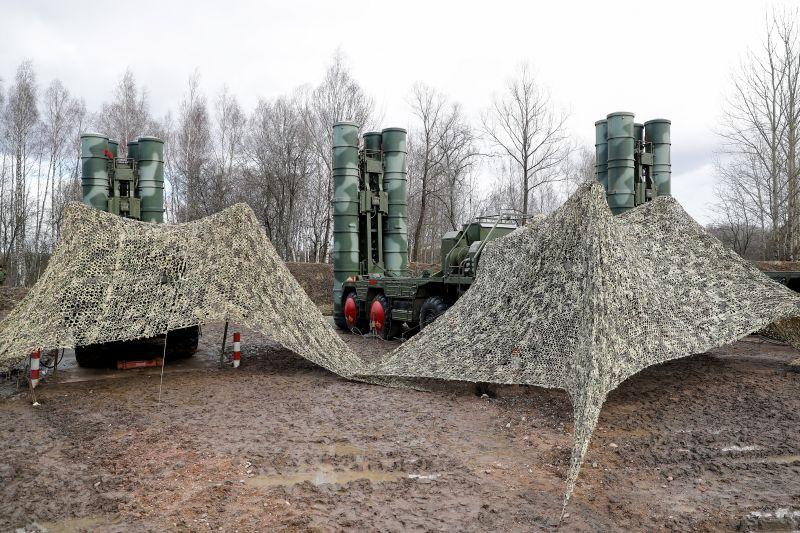The Russian experience of high-tech weapons-sales to foreign governments provides a few cautionary tales.
During a 3-day visit to Russia (November 5th – 7th), Indian Defence Minister Rajnath Singh discussed his government’s desire for the delivery-schedule for Russia’s sale of the S-400 air defence system to India to be sped up. This desire was expressed while speaking to his Russian counterpart Sergey Shoygu at the 19th meeting of the India-Russia Intergovernmental Commission on Military and Technical Cooperation (IRIGC-M&MTC) held in Moscow on November 6th.
With the capability to intercept and destroy aircraft at a range of 380 kilometers and hypersonic targets travelling at anything less than 17,000 kph from a range of 60 kilometers, the S-400 is envisaged to greatly strengthen India’s air-defence systems. Signed last year, the deal stipulated that 5 S-400 systems would be delivered to the Indian Ministry for Defence by the end of 2020, at a combined price of $5.4 billion. So far, 15% of the contract’s total price has been paid by the Indian government through channels set up to circumvent sanctions, with the remaining payments to be linked to the delivery-schedule. Today (November 7th), Minister Singh will visit a military-industrial concern in St. Petersburg which is involved in S-400 production.
The upgrade of India’s 10-year lease of a Russian Akula-class submarine to the newer generation Akula-1 sub was also discussed at the intergovernmental commission.
The Indian government has attached special priority to the S-400 deal, as it sees the S-400 as a more strategically efficient and cost-efficient alternative to replacing an aging fleet of fighter-planes. India is currently invested in weapons-procurement deals with Russia totaling $10 billion in value.
However, India’s plan to acquire the S-400 has met the strong objections of the United States, whose counter-offer of the Patriot missile-system was declined last year. The S-400 issue was one of the main points of contention when US Secretary of State Mike Pompeo met Indian Prime Minister Narendra Modi in New Dehli in June. This compounded tensions which had already arisen following the Indian government’s decision to increase tariffs on 28 product-categories imported from the US. The Trump administration retaliated by ending India’s preferential trade status.
In spite of this, the US clearly still has ambitions to deputize India in an effort to further its interests in what American policy-makers refer to as the “Indo-Pacific” zone, a theoretical “mega-region” spanning from the west coast of India to the west coast of the United States. The United States’ geo-strategic logic in this case is that India has every bit as much motivation to hinder Chinese economic (and territorial) ambitions in the Pacific as the US does, and that this point combined with China’s gradually solidifying strategic partnership with Russia means by implication that India’s own sense of geo-political self-interest might also make her a useful US supra-regional proxy in geo-strategic competition against Russia.
The United States Air Force is currently in possession of the S-400’s generational predecessor, the S-300 system. In April, it was reported that the US had acquired the S-300 system from an unknown source, and used it to train pilots at the Tonopah test range in Nevada. Furthermore, American pilots train against the S-300 system when carrying out joint military exercises with the Greek armed forces within the framework of NATO.
Deals such as these always involve a certain level of strategic risk, but even more so when the government buying a technologically advanced Russian weapons system is not ideologically or geo-strategically reliable, or is otherwise too easily pressurized. We might take note that, in spite of the fiscal and economic inadvisability of such a move, Greece inexplicably joined the Eurozone in 2001, only a few years after it had first acquired the S-300 system. If we were cynical (and why would we not be cynical?), then we might vaguely suspect that one purpose for which Greece’s debt-crisis was deliberately created was in order to pressurize the Greek state into becoming an instrument of subterfuge against Russia.
Regarding Russian-Indian relations as they translate into military-technical cooperation, there are those who will counter-argue that, while relationships between nation-states are never in principle based upon trust, Russia still has certain practical semi-assurances. For a start, India is a superpower, far less easily pressurized than a country such as Greece. Furthermore, India’s extremely long-standing relationship with Russia regarding weapons-sales and military-technical cooperation, stretching well back into the Soviet period, means that both governments already have a lot invested in the maintenance of their relationship.
However, those counter-arguments can only be weighed as factors rather than treated as guarantees. Is it totally inconceivable that, if some juicy carrot were dangled in front of it, the Indian government might one day agree to American requests for access to its S-400 systems, so that the system could be reverse-engineered?
Over the past few years, since Modi came to power, India has not been the most reliable BRICS-partner.
Partially owing to its inevitable regional rivalry with China, India (like Turkey) can be relied upon to always play both sides.
So with all that considered, the question arises as to what extent the Russian government should consider the S-400 deal with India a security-risk. The S-400 is an extremely valuable cash-cow, and its export indirectly confers a range of geo-political benefits (which I have discussed previously), but those benefits still come with risks attached.
Padraig McGrath, political analyst

